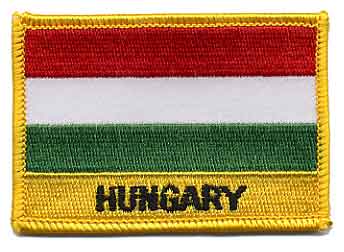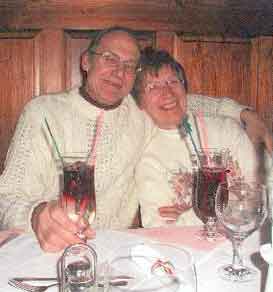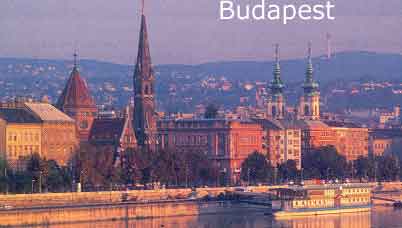

| Hungary |  |
|
|
Hungary - February 2002 The Reverend Doctor James Wiberg
Luray and I just returned from Budapest,
Hungary where we celebrated our 38th
Anniversary in this old city on the Danube.

We stayed at the Charles Hotel not
far from the Gellert Hill site of the murder of one of the first Christian
Bishops of the City. At the foot of the hill stands the famous
Gellert Hotel and the health spa founded many years ago by two famous
rheumatologists. People come here from all over the world to soak in
the tubs, take treatments from physiatrists and rheumatologists and, of
course, they try to have the hospitalization plan pay for it. No
such luck for us.
We first toured the city and its famous Danube
bridges by auto and then proceeded to buy metro passes for the subways,
trams and buses from the Hotel clerk.
For us westerners the most amazing thing about
this city is that most of the international tourist service people speak
an American dialect of English. I guess it also illustrates the
close ties we have had with this country over the years. Perhaps it
also reflects the fact that more than 600,000 Hungarians live in the U.S.,
the outcome of the many wars here. Our Hotel Clerk is a student
majoring in International Relations so he was a treasure trove of
information. We asked him about the Freedom Bridge which spans the
Danube in Budapest. We wanted to know which historic event it
memorialized. He responded jokingly by saying: "You
Americans have only one freedom rebellion to remember, but here we we have
many. This bridge commemorates the 1848 war when we gained some
measure of freedom from the Austrians."
Hungarians speak a language that is similar to
Finnish and distinct from all other Europeans; thus it is a unique culture
and a unique group of people. They have not been a free people for
many of their years as a distinct linguistic group having been subjected
by Romans, Yugoslavians, Austrians, and Russians. When I
tried to engage a stranger in a store in conversation about the Russian
era, she just clammed up and wouldn't even talk about it. I could
see no evidence of the Russian language anywhere in the city and we
were told that the offices of Aeroflot were even boarded up for awhile. However,
the offices were now open and I suspect that commerce and industry
may have won the day here. The city is thriving----of course,
there is still much to repair and to rebuild, but I sense that the young
people were especially energetic, enthusiastic and hopeful about their
future as a country. We join with others in wishing them success in
surmounting the many hurdles that still lie before them as they seek
entrance into the Europea Union.

We spent most of our time touring the castle
and the main walking street of downtown Budapest. The Internationals
retailers are ubiquitous here as elsewhere in Europe----Burger King,
McDonalds, Pizza Hut, The Hilton, Carlson Wagonlit, the ubiquitous
electronics, etc., but there are also many local stores and shops where
you can buy folklore items, antiques, and especially crystal, china
and ceramics. The transportation system works fine and trams and
buses run frequently to the main areas of the city. Most people seem
to know a few words of English and could give us directions.
The real surprise for us this trip was the
First Class Restaurant in our 3-star hotel, The Charles. It was a
new Restaurant, separately owned but directly attached to the Hotel Lobby.
Courtesy drinks were a part of the plan. We had fully intended to go to
one of Dave and Jenn's favorite Restaurants in Budapest, the Marquis de
Salade, down near the Opera House for our Anniversary Meal. While we
were having our courtesy drinks, we watched the staff prepare the dining
room, lighting candles, playing "easy-listening" music.
Well trained and courteous, fluent in English, friendly, the waiter was
told by our friends that we were celebrating our Anniversary.
Immediately the waiter offered us a special "house drink"---a
very unusual "schnapps" ---a plum Brandy complete with Prune on
a colorful plastic toothpick. It slowly dawned on us that it
might be smart to look at a menu and we then realized that we did not need
to go any farther. We settled down to a wonderful dinner of
three different types of Hungarian Cuisine--beef, chicken and veal, an
exquisitely presented salad, with a fine dry red wine from the Danubian
hills. I think their new Chef had learned it
well-----"it's all in the presentation." The Hotel
provided secured parking in their courtyard, an internet lounge and every
room was equipped like an apartment with small kitchen and full bath.
On Saturday, we toured the main shopping
street in the Old City and then started a motor trip along the Danube. We
drove by the ancient Roman ruins of Acquinum---a treasure trove for any archaeologist
and noted the excavations of the waterworks and steam baths of these
ancient, clever engineers. We had heard about a colony of Serbs who
had settled along the Danube during one of their battles with the Turks.
Szentendre, as it is called having been named after Saint Andrew, is now
an artist's village with many old and narrow streets, filled with all
kinds of shops, restaurants and churches. For lunch we ordered
Hungarian Gulasch with soft white bread, at a local Restaurant, shopped
for unique gifts and enjoyed the the camaraderie with our friends, the
Voths, who are fellow travelers with us in the Vienna scene. I won't
tell you what we bought so that some of you can just continue to be
curious and hopefully surprised when we finally show up on your doorstep
sometime.
Continuing our journey along the Danube we
stopped next at Ezstergom, site of a Basilica of the Roman Catholic Church
of Hungary and seat of the Archbishop. The Basilica is a huge
fortress like structure on a hilltop along the Danube in the old part of
the City. The country is about 60% Roman Catholic, about 20%
Evangelical Protestant with the usual smattering of other religions. From
Eztergom we drove through several little towns and villages and then
entered the Autobahn for the short trip back to Vienna.
[Editor's Note: This 19th-century Chain Bridge links the ancient Buda and the modern Pest.]
Think Globally - Act Locally - Pray for World Peace |